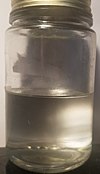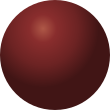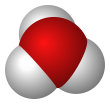Hydrobromic acid
| |||
| |||
 | |||
| Names | |||
|---|---|---|---|
| IUPAC name Bromane[1] | |||
| Other names Hydronium bromide Bromhydric acid | |||
| Identifiers | |||
CAS Number |
| ||
3D model (JSmol) |
| ||
| ChEBI |
| ||
| ChEMBL |
| ||
| ChemSpider |
| ||
| ECHA InfoCard | 100.240.772 | ||
| EC Number |
| ||
Gmelin Reference | 620 | ||
| KEGG |
| ||
PubChem CID |
| ||
| RTECS number |
| ||
| UNII |
| ||
| UN number | 1048 1788 | ||
InChI
| |||
| |||
| Properties | |||
Chemical formula | HBr(aq) | ||
| Molar mass | 80.91 g·mol−1 | ||
| Appearance | colorless liquid (impure samples can appear yellowish) | ||
| Odor | acrid | ||
| Density | 1.49 g/cm3 (48% w/w aq.) | ||
| Melting point | −11 °C (12 °F; 262 K) (47–49% w/w aq.) | ||
| Boiling point | 122 °C (252 °F; 395 K) at 700 mmHg (47–49% w/w aq.) | ||
| 221 g/100 mL (0 °C) 204 g/100 mL (15 °C) 130 g/100 mL (100 °C) | |||
| Acidity (pKa) | −9[2] | ||
| Viscosity | 0.84 cP (−75 °C) | ||
| Thermochemistry | |||
Heat capacity (C) | 29.1 J/(K·mol) | ||
Std molar entropy (S⦵298) | 198.7 J/(K·mol) | ||
Std enthalpy of formation (ΔfH⦵298) | −36.3 kJ/mol | ||
| Hazards | |||
| GHS labelling: | |||
  | |||
| Danger | |||
| H314, H335 | |||
| P260, P261, P264, P271, P280, P301+P330+P331, P303+P361+P353, P304+P340, P305+P351+P338, P310, P312, P321, P363, P403+P233, P405, P501 | |||
| NFPA 704 (fire diamond) |  3 0 0 ACID | ||
| Flash point | Non-flammable | ||
| Safety data sheet (SDS) | ICSC 0282 | ||
| Related compounds | |||
Other anions | Hydrofluoric acid Hydrochloric acid Hydroiodic acid | ||
Related compounds | Hydrogen bromide | ||
Except where otherwise noted, data are given for materials in their standard state (at 25 °C [77 °F], 100 kPa).  N verify (what is N verify (what is  Y Y N ?) N ?) Infobox references | |||
Hydrobromic acid is an aqueous solution of hydrogen bromide. It is a strong acid formed by dissolving the diatomic molecule hydrogen bromide (HBr) in water. "Constant boiling" hydrobromic acid is an aqueous solution that distills at 124.3 °C (255.7 °F) and contains 47.6% HBr by mass, which is 8.77 mol/L. Hydrobromic acid is one of the strongest mineral acids known.
Uses
Hydrobromic acid is mainly used for the production of inorganic bromides, especially the bromides of zinc, calcium, and sodium. It is a useful reagent for generating organobromine compounds. Certain ethers are cleaved with HBr. It also catalyzes alkylation reactions and the extraction of certain ores. Industrially significant organic compounds prepared from hydrobromic acid include allyl bromide, tetrabromobis(phenol), and bromoacetic acid. HBr almost uniquely participates in anti-Markovnikov hydrohalogenation of alkenes. The resulting 1-bromoalkanes are versatile alkylating agents, giving rise to fatty amines and quaternary ammonium salts.[3]
Synthesis
Hydrobromic acid can be prepared in the laboratory via the reaction of Br2, SO2, and water.[4]
More typically laboratory preparations involve the production of anhydrous HBr, which is then dissolved in water.
Hydrobromic acid has commonly been prepared industrially by reacting bromine with either sulfur or phosphorus and water. However, it can also be produced electrolytically.[4] It can also be prepared by treating bromides with non-oxidising acids like phosphoric or acetic acids.
Alternatively the acid can be prepared with dilute (5.8M) sulfuric acid and potassium bromide:[5]
Using more concentrated sulfuric acid or allowing the reaction solution to exceed 75 °C further oxidizes HBr to elemental bromine. The acid is further purified by filtering out the KHSO4 and by distilling off the water until the solution reaches an azeotrope (124.3 °C). The yield is approximately 85%.[5]
Hydrobromic acid is available commercially in various concentrations and purities.
References
- ^ Favre, Henri A.; Powell, Warren H., eds. (2014). Nomenclature of Organic Chemistry: IUPAC Recommendations and Preferred Names 2013. Cambridge: The Royal Society of Chemistry. p. 131. ISBN 9781849733069.
- ^ Bell, R. P. The Proton in Chemistry, 2nd ed., Cornell University Press, Ithaca, NY, 1973.
- ^ Dagani, M. J.; Barda, H. J.; Benya, T. J.; Sanders, D. C. (2012). "Bromine Compounds". Ullmann's Encyclopedia of Industrial Chemistry. Weinheim: Wiley-VCH. doi:10.1002/14356007.a04_405. ISBN 978-3527306732.
- ^ a b Scott, A. (1900). "Preparation of Pure Hydrobromic Acid". Journal of the Chemical Society, Transactions. 77: 648–651. doi:10.1039/ct9007700648.
- ^ a b Brauer, Georg (1963). Handbook of Preparative Inorganic Chemistry. Vol. 1 (2nd ed.). New York: Academic Press. p. 285. ISBN 978-0121266011.
External links
 Media related to Hydrogen bromide at Wikimedia Commons
Media related to Hydrogen bromide at Wikimedia Commons
- International Chemical Safety Card 0282
- NIOSH Pocket Guide to Chemical Hazards
- Carlin, W. W. U.S. patent 4,147,601
- v
- t
- e
| HBr | He | ||||||||||||||||||||
| LiBr | BeBr2 | BBr3 +BO3 | CBr4 +C | NBr3 BrN3 NH4Br NOBr +N | Br2O BrO2 Br2O3 Br2O5 | BrF BrF3 BrF5 | Ne | ||||||||||||||
| NaBr | MgBr2 | AlBr AlBr3 | SiBr4 | PBr3 PBr5 PBr7 +P | S2Br2 SBr2 | BrCl | Ar | ||||||||||||||
| KBr | CaBr2 | ScBr3 | TiBr2 TiBr3 TiBr4 | VBr2 VBr3 | CrBr2 CrBr3 | MnBr2 | FeBr2 FeBr3 | CoBr2 | NiBr2 NiBr42− | CuBr CuBr2 | ZnBr2 | GaBr3 | GeBr2 GeBr4 | AsBr3 +As +AsO3 | SeBr2 SeBr4 | Br2 | Kr | ||||
| RbBr | SrBr2 | YBr3 | ZrBr3 ZrBr4 | NbBr5 | MoBr2 MoBr3 MoBr4 | TcBr4 | RuBr3 | RhBr3 | PdBr2 | AgBr | CdBr2 | InBr InBr3 | SnBr2 SnBr4 | SbBr3 +Sb -Sb | Te2Br TeBr4 +Te | IBr IBr3 | XeBr2 | ||||
| CsBr | BaBr2 | * | LuBr3 | HfBr4 | TaBr5 | WBr5 WBr6 | ReBr3 | OsBr3 OsBr4 | IrBr3 IrBr 4 | PtBr2 PtBr4 | AuBr AuBr3 | Hg2Br2 HgBr2 | TlBr | PbBr2 | BiBr3 | PoBr2 PoBr4 | AtBr | Rn | |||
| FrBr | RaBr2 | ** | Lr | Rf | Db | Sg | Bh | Hs | Mt | Ds | Rg | Cn | Nh | Fl | Mc | Lv | Ts | Og | |||
| * | LaBr3 | CeBr3 | PrBr3 | NdBr2 NdBr3 | PmBr3 | SmBr2 SmBr3 | EuBr2 EuBr3 | GdBr3 | TbBr3 | DyBr3 | HoBr3 | ErBr3 | TmBr2 TmBr3 | YbBr2 YbBr3 | |||||||
| ** | AcBr3 | ThBr4 | PaBr4 PaBr5 | UBr4 UBr5 | NpBr3 NpBr4 | PuBr3 | AmBr2 AmBr3 | CmBr3 | BkBr3 | CfBr3 | EsBr2 EsBr3 | Fm | Md | No | |||||||

















